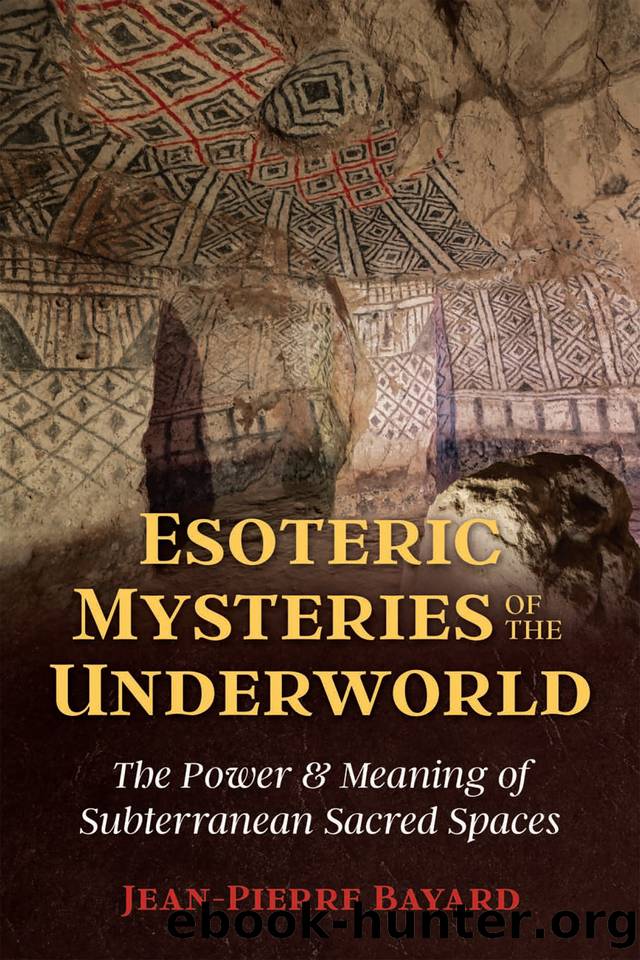Esoteric Mysteries of the Underworld: The Power and Meaning of Subterranean Sacred Spaces by Bayard Jean-Pierre

Author:Bayard, Jean-Pierre [Bayard, Jean-Pierre]
Language: eng
Format: epub
Publisher: Inner Traditions/Bear & Company
Published: 2020-10-24T16:00:00+00:00
15
Burial Caves
THE WORD GROTTO COMES FROM the Latin crypta, meaning âcrypt.â This underground vault of the church once served as the sepulcher for martyrs. Orbigny analyzed this kind of cave in his Dictionnaire dâHistoire Naturelle (article by Desnoyers). The grottoes of Arkalokhou (3000â2100 BCE), of Canaris, and of Psychro were used in Cretan worship, but I am only envisioning the burial rites outside the general worship of the dead. 1
The man of the Lower Paleolithic era shrouded his dead and powdered them in red (often with hematite). A stone was also placed under their heads. The same rite existed during the Mousterian era as the body was interred beneath the hearth. During the Neolithic era, the cave became a veritable tomb. After the body had been deposited inside, the entrance was walled off.
As for initiatory rites, artificial grottoes were created if natural ones were not available. âPeking manâ (Sinanthropus pekinensis ) is presumed to have lived in the cave in âChicken-Bone Hill.â This civilization knew the use of fire, and for around five thousand years used quartz crystals in their tools. The same ritualistic thinking erected the dolmens and covered alleys and tumuli. The corpse was not laid flat as in our time but in a curled position with the knees drawn up to the chest and the limbs pressed close together. The individual was thus returned to the earth, his nurturing mother, in a fetal position. Some authors have written that this was done in order to prevent the dead person from returning to the world, as he had no business concerning himself with the affairs of the living. This reasoning implies that the dead individual wanted revenge on those who had the privilege of remaining on earth.
In a civilization like that of the neomatriarchal farmers, burial was performed in two stages. It was necessary to wait until enough flesh had come off the skeleton so that the skull and long bones could be put in the appropriate place. 2 Skulls allegedly possessed supernatural powers. They presided over the major holidays and over the rites of initiation. Masonic writers have said that the skull placed in the chamber of reflection frightened the postulant and showed him the vanity of all things. I see an older rite within it: it is a guide placed by the side of the neophyte whose magical power attracts the motivating souls that reside in the celestial spheres to come to it. The arrival of a spirit allows for a palpable perception to take place. 3 These souls of an intermediary world, with their ethereal visions, liberate us from our heaviness, and the individual becomes open to new spiritual notions. He discovers the notion of imagination, prophetic inspiration, and even that of visions. This inner illumination can be achieved by means of initiation. The initiations of current secret societies have lost too much of their power to provide a true illumination.
The dead man has been revered in all eras, not only because he is the
Download
This site does not store any files on its server. We only index and link to content provided by other sites. Please contact the content providers to delete copyright contents if any and email us, we'll remove relevant links or contents immediately.
Animal Frequency by Melissa Alvarez(4399)
Sigil Witchery by Laura Tempest Zakroff(4181)
Real Magic by Dean Radin PhD(4077)
Fingerprints of the Gods by Graham Hancock(3943)
Aleister Crowley: The Biography by Tobias Churton(3589)
Journeys Out of the Body by Robert Monroe(3573)
The Rosicrucians by Christopher McIntosh(3469)
Alchemy and Alchemists by C. J. S. Thompson(3453)
Mysteries by Colin Wilson(3399)
Hitler's Monsters by Eric Kurlander(3270)
The Hatha Yoga Pradipika (Translated) by Svatmarama(3236)
John Dee and the Empire of Angels by Jason Louv(3133)
Wicca: a guide for the solitary practitioner by Scott Cunningham(3127)
Infinite Energy Technologies by Finley Eversole(2939)
Book of Life by Deborah Harkness(2869)
Dark Star Rising by Gary Lachman(2830)
The Book of Lies by Aleister Crowley(2803)
Aliens by Jim Al-Khalili(2788)
To Light a Sacred Flame by Silver RavenWolf(2770)
